Designing Software with Empathy: Inclusive Development for All Users
Creating Inclusive Digital Experiences for All Users
Introduction🙏
In today's interconnected world, software developers have the power to create applications that touch the lives of people from all walks of life. It is crucial for developers to approach their work with empathy, ensuring that their software is accessible and inclusive for users regardless of their profession, education level, or background.
In this article, we will explore the importance of designing software with care, paying special attention to the needs and behaviours of users from diverse backgrounds.
By incorporating user research and interviews into the development process, developers can create software that truly caters to the needs of every user, including those who may be less educated or work in unconventional professions.
Understanding User Diversity 🤔
Users of software applications come from diverse backgrounds, professions, and educational levels. As developers, it is our responsibility to recognize and respect this diversity.
Every user should be able to navigate and utilize software seamlessly, regardless of their educational background or profession.
By understanding the challenges and needs of users from different walks of life, developers can create interfaces that are intuitive, inclusive, and cater to a wide range of users.
Importance of Empathy in Software Development 🧑💻👩💻
Empathy is a key element in designing user-centric software. Developers should strive to put themselves in the shoes of the end user, considering their unique circumstances, limitations, and preferences.
By empathizing with users who may have limited technical knowledge or unconventional work experiences, developers can create software that is easy to understand and use.
Tracking Usage Behavior Through User Research 🏃♂️
User research plays a vital role in understanding how people interact with software. By conducting interviews, surveys, and usability tests, developers can gain insights into the behaviours and preferences of their target users.
When designing software for users with varying levels of education or professional backgrounds, it is important to conduct research specifically tailored to those groups.
This research can help uncover pain points, identify usability issues, and inform design decisions that improve the overall user experience.
Designing for Accessibility 🦾
Inclusive software development also entails designing for accessibility. Developers should consider the needs of users with disabilities or limited digital literacy.
Incorporating features such as clear and concise instructions, visual cues, and easily navigable interfaces can make the software more accessible to a wider audience.
By embracing accessibility standards and guidelines, developers can ensure that their software is usable by everyone, regardless of their educational background or profession.
Conclusion 🥇🙏
As software developers, we have the power to shape the experiences of millions of users worldwide. It is our responsibility to design software that is inclusive and accessible to users from diverse backgrounds, including those who may be less educated or work in unconventional professions.
By approaching development with empathy, conducting user research, and paying attention to accessibility, we can create software that truly caters to the needs of all users.
Let us strive to build a digital world that embraces diversity and empowers every user to leverage the benefits of technology.
Cheers! 🥂🥂

